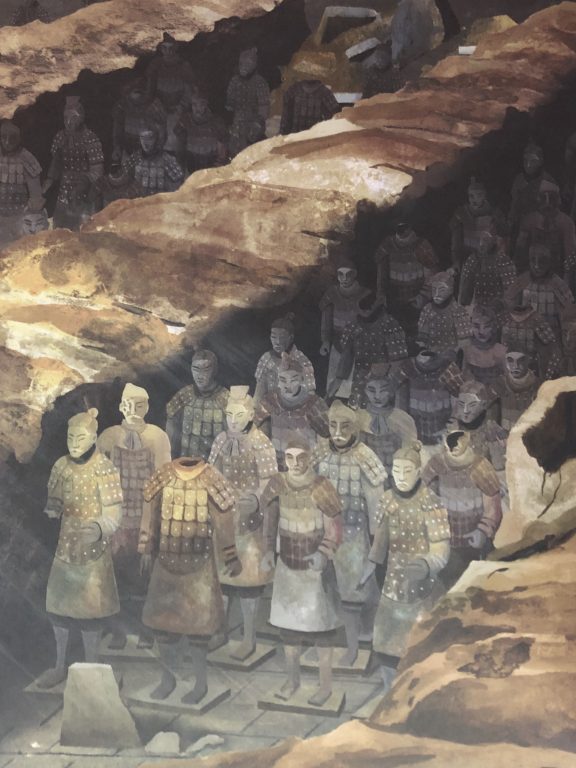One of the chapters of my new book, Strange But True, tells the story of the discovery of the tomb of Tutankhamun in 1922. Tutankhamun died young and was buried amidst golden treasure in the Valley of Kings in Egypt. Supposedly, the people who visited or disturbed the tomb wound up victims of a horrible curse. (Spoiler alert: the curse wasn’t real — the media invented it.)
I originally wanted to open this chapter with the story of a different tomb, one in China. However, I was unable to find any evidence that anyone believed in a curse associated with this tomb. The story of its discovery is a wonderful one, though. Here it is:
Pickaxes and shovels hit the dusty ground, digging down towards water. It is March of 1974 in Shaanxi province in central China. A winter drought has parched orchards of persimmon and pomegranate trees. So farmer Yang Zhifa, along with his brothers and a friend, are digging a well. After a few days of hard work, something unusual emerges. It’s a headless human torso made of pottery. Nearby, the farmers find bronze arrowheads, fragments of broken pottery, and more clay body parts. “I told my friend, this is a temple,” Yang later recalls.[1] But they need water, so they keep digging. Some of the people who live in the farmers’ village aren’t happy to see the broken figures. They worry that they might have disturbed an old god or an evil spirit. Could it bring disaster to the village?
When a local archaeologist hears of the discovery, he bikes over to investigate. He soon realizes that this is a remarkable find. It is not a temple, but part of an elaborate tomb built for China’s first emperor over 2,000 years ago. The figures are archers, infantry, cavalry, charioteers, and generals, along with their weapons and horses, all made from terracotta (a type of fired clay). They are life-sized, with facial features that seem unique. Around 8,000 warriors lie hidden beneath the farmers’ fruit trees. But why? Why make so many beautiful statues, then bury them in a tomb?
Rivers of Mercury and Gemstone Stars
Like many other early civilizations, the ancient Chinese believed in an afterlife. They also practiced slavery and human sacrifice. During the Shang dynasty, from around 1600 to 1046 BC, servants and slaves were commonly killed in the belief that they would continue to serve a king or other powerful figure in the afterlife. When the Duke Qin Jing Gong died in 537 BC, around 166 male and female slaves were sacrificed and buried with him. Over time, this practice fell out of favor. Instead, people buried figurines representing servants. But as far as scholars know, the first emperor Qin Shi Huang is the only one who ever crafted an entire, life-sized army for burial. During his reign, he had conquered a group of warring states, joining them into one nation in 221 BC. This nation became known as China. Qin Shi Huang likely believed that he needed an army in the afterlife to continue his conquests and to protect him from his enemies. Today, around 2,000 figures have been restored. Many stand in formation in a large museum located where the farmers’ orchards once stood.
A short distance away sits a high mound covered in trees. This is the main tomb, the place where the body of the first emperor is believed to be buried. However, the tomb has never been excavated. About a hundred years after the first emperor’s death, historian Sima Qian chronicled his reign. He wrote that the tomb is filled with treasures, including a miniature map of the empire with rivers and oceans of mercury on the floor and stars and planets made of pearls and gems on the ceiling. To protect the tomb, the history says, builders rigged crossbows to shoot at anyone who dared try to enter. Sima Qian also wrote that the emperor killed many of the slaves and craftspeople who labored on the tomb, in order to protect its secrets. At least some of this description seems to be true, as archaeologists have found high levels of mercury around the tomb and pits filled with the bodies of laborers.
It seems that the emperor did not want anyone stealing his treasures or disturbing his monument. So far, he’s had his wish. Xiuzhen Li is an archaeologist who studies the terracotta army. She says, “Many people wish to see the treasures inside, to see the mysteries inside, but we cannot.”[2] Opening the tomb would mean disrespect to a figure who is very important in Chinese history and might damage the artifacts inside. So Li and her colleagues are hoping that future technology will allow them to see inside without disturbing the contents. What will they find? She has no idea. No one ever expected to find an army of almost 8,000 life-sized warriors. Sima Qian did not even mention them in his history. The mysteries awaiting in the main tomb could be truly fantastic.
[1]. “The Emperor’s Ghost Army.” Nova, Season 41, Episode 20, WGBH, November 12, 2014.
[2]. Xiuzhen Li. Personal Interview, September 12, 2018.
Read more about curses and ancient tombs in Strange But True, coming out October 1, 2019.

